2 to the power π - exponential function for an irrational value of x
Categories: exponentials

How can we find the value of a to the power x where x is an irrational number? For example, what is 2 to the power π?
The normal definition of a to the power n, when n is a positive integer, is a multiplied by itself n times. But how can we multiply a by itself π times?
If you try this on a calculator you will get something like 8.824977827, so it is clearly possible.
We have already seen how to raise a to any rational power. We will briefly recap this idea. Then we will look at how we can define and calculate the value of a number raised to an irrational power.
Raising a number to a rational power
Raising a positive number a to a positive integral power n is straightforward. As we saw before, it is simply a multiplied by itself n times:

Raising a to the power 1/n is slightly more tricky. But we know that when we multiply exponential terms together we add the exponents. So if we multiply a to the power 1/n by itself n times we get a:

This tells us that:
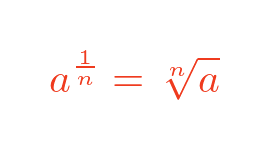
Finally, raising a to any rational power m/n is equivalent to finding the nth root of a to the power m:

Irrational powers
If we want to raise a number to an irrational power, for example 2 to the power π, we face a problem. Since π is irrational, we can't express it as a fraction m/n:
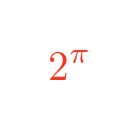
This applies to any case where the exponent is irrational. For example, if we wish to raise a number to the power e, Euler's number:

or even if we wish to raise a number to the power of an irrational root:
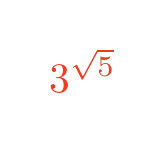
Using a rational approximation to π
One possible solution to find an approximation to the value of 2 to the power π is to use a rational approximation to π to perform the calculation.
We could approximate π as 3. It is easy to calculate 2 cubed, and this gives a very approximate value for 2 to the power π:
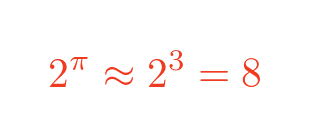
This very approximate value is not too far away from the number you would obtain from a calculator.
A slightly better approximation would be 31/10, or 3.1. This is a rational number, so we can calculate the value of 2 to the power 31/10. It is the 10th root of 2 to the power 31:

Even better would be 314/100, or 3.14, which is also a rational number that is even closer to π.

In fact, we could choose a rational number that is equal to π to p decimal places. For a large enough value of p, the approximation can get as close to π as we like.
Problem with this approach
The main problem with this approach is that it is extremely impractical, even for quite small values p. For example, if we try to use π to 8 decimal places, we would need to raise 2 to the power 314,159,265 and then take the 100 millionth root of the result.
The problem here is that 2 to the power 314,159,265 is a quite large number. It is an integer with about 100 million digits. It is far larger than a calculator or most computer programming languages can deal with. Simply printing that number out would fill 20,000 sides of A4 paper. And that is only half the calculation, we still need to find the 100 millionth root of that large number.
We can't really do anything practical with such a large number. So while this approach is theoretically capable of representing the value of 2 to the power π to any required precision, it isn't a particularly useful way of doing it.
Using the exponential function
The exponential function is e to the power x, where e is Euler's number:

The useful thing about the exponential function is that it can be expressed as a Maclaurin series like this:

This series allows us to calculate an approximate value of e to the x for any value of x. It has several advantages:
- It is a continuous function. This means that it can accept any value of x, even an irrational number like π or the square root of 5.
- It converges quite quickly, which means you can calculate a reasonable approximation using just a few terms.
- It doesn't involve any ridiculously large numbers.
This works well provided we are using e as our base. But what if we want to use 2, or any other number, as the base?
It is possible to change the base of a power using this formula:
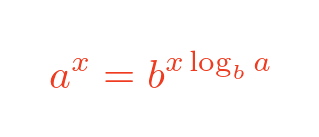
Where a and b have any positive value other than 1.
We can set:
- a to 2, the initial base.
- b to e, the base we are converting to.
- x to π, the exponent.
- log to base b becomes log to base e, usually called the natural log function, ln.
This gives us an expression for 2 to the π:
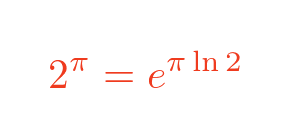
This can be calculated by plugging the value π times ln 2 into the Maclaurin series given earlier.
General formula for irrational powers
If we define a to the power x as:
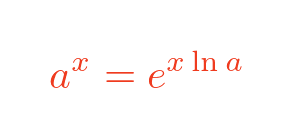
This is valid for all positive a and real x.
Since we can calculate the exponential function for any real x, this formula allows us to calculate a to an irrational power.
Related articles
Join the GraphicMaths Newsletter
Sign up using this form to receive an email when new content is added to the graphpicmaths or pythoninformer websites:

Popular tags
adder adjacency matrix alu and gate angle answers area argand diagram binary maths cardioid cartesian equation chain rule chord circle cofactor combinations complex modulus complex numbers complex polygon complex power complex root cosh cosine cosine rule countable cpu cube decagon demorgans law derivative determinant diagonal directrix dodecagon e eigenvalue eigenvector ellipse equilateral triangle erf function euclid euler eulers formula eulers identity exercises exponent exponential exterior angle first principles flip-flop focus gabriels horn galileo gamma function gaussian distribution gradient graph hendecagon heptagon heron hexagon hilbert horizontal hyperbola hyperbolic function hyperbolic functions infinity integration integration by parts integration by substitution interior angle inverse function inverse hyperbolic function inverse matrix irrational irrational number irregular polygon isomorphic graph isosceles trapezium isosceles triangle kite koch curve l system lhopitals rule limit line integral locus logarithm maclaurin series major axis matrix matrix algebra mean minor axis n choose r nand gate net newton raphson method nonagon nor gate normal normal distribution not gate octagon or gate parabola parallelogram parametric equation pentagon perimeter permutation matrix permutations pi pi function polar coordinates polynomial power probability probability distribution product rule proof pythagoras proof quadrilateral questions quotient rule radians radius rectangle regular polygon rhombus root sech segment set set-reset flip-flop simpsons rule sine sine rule sinh slope sloping lines solving equations solving triangles square square root squeeze theorem standard curves standard deviation star polygon statistics straight line graphs surface of revolution symmetry tangent tanh transformation transformations translation trapezium triangle turtle graphics uncountable variance vertical volume volume of revolution xnor gate xor gate
